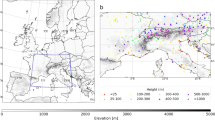Abstract
The Advanced Research WRF (Weather Research and Forecasting) model is used to simulate the evolution of a mesoscale convective vortex (MCV) that formed on the Meiyu front and lasted for more than two days. The simulation is used to investigate the underlying reasons for the genesis, intensification, and vertical expansion of the MCV. This MCV is of a type of mid-level MCV that often develops in the stratiform regions of mesoscale convective systems. The vortex strengthened and reached its maximum intensity and vertical extent (from the surface to upper levels) when secondary organized convection developed within the mid-level circulation. The factors controling the evolution of the kinetic and thermal structure of the MCV are examined through an analysis of the budgets of vorticity, temperature, and energy. The evolution of the local Rossby radius of deformation reveals the interrelated nature of the MCV and its parent mesoscale convective system.
Similar content being viewed by others
References
Bartels, D. L., and R. A. Maddox, 1991: Mid-level cyclonic vortices generated by mesoseale convective systems. Mon. Wea. Rev., 119, 104–118.
Chen Liqiang, Chen Shoujun, Zhou Xiaoshan, et al., 2005: A numerical study of the MCS in a cold vortex over-northeastern China. Acta Meteor. Sinica, 63(2), 173–183. (in Chinese)
Chen, S. S., and W. M. Frank, 1993: A numerical study of the genesis of extratropical convective mesovortices. Part I: Evolution and dynamics. J. Atmos. Sci., 50, 2401–2426.
Conzemius, R. J., R. W. Moore, M. T. Montgomery, et al., 2007: Mesoscale convective vortex formation in a weakly sheared moist neutral environment. J. Atmos. Sci., 64, 1443–1466.
—, and M. T. Montgomery, 2010: Mesoscale convective vortices in multiscale, idealized simulations: Dependence on background state, interdependency with moist baroclinic cyclones, and comparison with BAMEX observations. Mon. Wea. Rev., 138, 1119–1139.
Davis, C. A., and M. L. Weisman, 1994: Balanced dynamics of mesoscale vortices produced in simulated convective systems. J. Atmos. Sci., 51, 2005–2030.
—, and T. J. Galarneau Jr., 2009: The vertical structure of mesoscale convective vortices. J. Atmos. Sci., 66, 686–704.
Durran, D. R., and J. B. Klemp, 1982: On the effects of moisture on the Brunt-Väisälä frequency. J. Atmos. Sci., 39, 2152–215
Fritsch, J. M., J. D. Murphy, and J. S. Kain, 1994: Warm core vortex amplification over land. J. Atmos. Sci., 51, 1780–1807.
Galarneau, T. J. Jr., L. F. Bosart, C. A. Davis, et al., 2009: Baroclinic transition of a long-lived mesoscale convective vortex. Mon. Wea. Rev., 137, 562–584.
Gamache, J. F., and R. A. Houze Jr., 1982: Mesoscale air motions associated with a tropical squall line. Mon. Wea. Rev., 110, 118–135.
Haynes, P. H., and M. E. McIntyre, 1987: On the evolution of vorticity and potential vorticity in the presence of diabatic heating and frictional or other forces. J. Atmos. Sci., 44, 828–841.
Houze, R. A., Jr., 1977: Structure and dynamics of a tropical squall-line system. Mon. Wea. Rev., 105, 1540–1567.
Jiang, H. L., and D. J. Raymond, 1995: Simulation of a mature mesoscale convective system using a nonlinear balance model. J. Atmos. Sci., 52, 161–175.
Jiang Yongqiang and Wang Yuan, 2012: Nummerical simulation on the formation of mesoscale vortex in Col field. Acta Meteor. Sinica, 26(1), 112–128.
Kirk, J. R., 2003: Comparing the dynamical development of two mesoscale convective vortices. Mon. Wea. Rev., 131, 862–890.
Knievel, J. C., and R. H. Johnson, 2003: A scale-discriminating vorticity budget for a mesoscale vortex in a midlatitude, continental convective mesoscale system. J. Atmos. Sci., 60, 781–794.
Lin, Y.-L., R. D. Farley, and H. D. Orville, 1983: Bulk parameterization of the snow field in a cloud model. J. Climate Appl. Meteor., 22, 1065–1092.
Liu, C. H., K. Ikeda, G. Thompson, et al., 2011: High-resolution simulations of wintertime precipitation in the Colorado headwaters region: Sensitivity to physics parameterizations. Mon. Wea. Rev., 139, 3533–3553.
Menard, R. D., and J. M. Fritsch, 1989: A mesoscale convective complex-generated inertially stable warm core vortex. Mon. Wea. Rev., 117, 1237–1261.
Raymond, D. J., and H. Jiang, 1990: A theory for long-lived mesoscale convective systems. J. Atmos. Sci., 47, 3067–3077.
Rogers, R. F., and J. M. Fritsch, 2001: Surface cyclogenesis from convectively driven amplification of mid-level mesoscale convective vortices. Mon. Wea. Rev., 129, 605–637.
Xu Wenhui, Ni Yunqi, Wang Xiaokang, et al., 2012: The evolution of a meso-β-scale convective vortex in the Dabie mountain area. Acta Meteor. Sinica, 26(5), 597–613.
Yu, C.-K., B. J.-D. Jou, and B. F. Smull, 1999: Formative stage of a long-lived mesoscale vortex observed by airborne Doppler radar. Mon. Wea. Rev., 127, 838–857.
Zhang, D.-L., 1992: The formation of a cooling-induced mesovortex in the trailing stratiform region of a midlatitude squall line. Mon. Wea. Rev., 120, 2763–2785.
—, and J. M. Fritsch, 1987: Numerical simulation of the meso-β scale structure and evolution of the 1977 Johnstown flood. Part II: Inertially stable warmcore vortex and the mesoscale convective complex. J. Atmos. Sci., 44, 2593–2612.
Zhang Xiaohui and Ni Yunqi, 2010: A diagnostic case study on the comparison between the frontal and on-frontal convective-systems. Acta Meteor. Sinica, 24(1), 66–77.
Author information
Authors and Affiliations
Corresponding author
Additional information
Supported by the National Natural Science Foundation of China (40875028) and National Key Basic Research and Development (973) Program of China (2013CB430103).
Rights and permissions
About this article
Cite this article
Wang, J., Pan, Y. & Wang, S. A numerical study of the evolution of a mesoscale convective vortex on the Meiyu front. Acta Meteorol Sin 27, 889–909 (2013). https://doi.org/10.1007/s13351-013-0509-9
Received:
Accepted:
Published:
Issue Date:
DOI: https://doi.org/10.1007/s13351-013-0509-9




